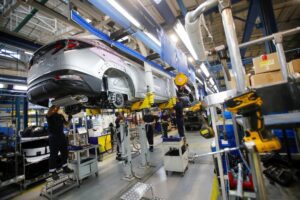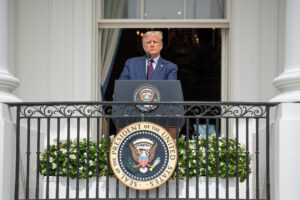Does Hyundai’s “America First” Investment Mean South Korea Comes Second?

The following is an excerpt:
Hyundai’s latest U.S. investment stood out not only for its unprecedented scale, but also for its scope. According to the company, of the $21 billion investment from 2025 to 2028, $9 billion will be invested in expanding Hyundai Motor’s production capacity, raising the company’s annual output in the U.S. to 1.2 million vehicles. This figure includes production across all three of Hyundai Motor’s facilities in America – its plant in Montgomery, Alabama; affiliate Kia Motors’ facility in West Point, Georgia; and the newly launched Metaplant in Ellabell, Georgia. Given that Hyundai and Kia together, according to the Korea Automobile & Mobility Association, produced about 7.23 million vehicles globally in 2023, with 49.1 percent – or roughly 3.55 million units – manufactured in South Korea, Hyundai’s bold push to produce 1.2 million units annually in the U.S. alone, nearly 34 percent of its domestic output, marked a notable shift.
More strikingly, another $6 billion will be invested in building Hyundai Steel’s first overseas production base – a new facility in Louisiana. With the capacity to produce 2.7 million tons of steel annually, the steel mill aims to enhance “the [Hyundai] Group’s agility and flexibility in response to external uncertainties,” reflecting the company’s effort to address both the 25 percent auto tariffs and the 25 percent steel tariffs under Trump 2.0. Considering Hyundai ranked fourth in the U.S. auto sales in 2023 and 2024 – behind General Motors (GM), Toyota, and Ford – with a record 1.7 million units sold last year, the move explains the company’s deepening commitment to the U.S. market – not just as a sales destination, but as a full-scale production hub aligned with Washington’s trade and policy dynamics.
Against this backdrop, it is important to note that the investment marks a pivotal step in Hyundai’s U.S. supply chain strategy, enabling end-to-end production of vehicles sold in the U.S. to take place entirely within the country. It represents an unprecedented move toward full vertical integration – from scrap metal to final vehicle assembly – all in America. Furthermore, Hyundai’s EV battery suppliers located near its car production facilities – such as its joint facilities with SK On and LG Energy Solution, both located in Georgia – are expected to firmly anchor its U.S. manufacturing ecosystem. In his White House remarks, Executive Chairman Chung also pledged to purchase $3 billion worth of U.S. LNG, stating that these combined efforts “will accelerate the localization of [Hyundai’s] supply chain in the U.S., expand our operations and grow our American workforce.” The company expects the investment to generate over 100,000 direct and indirect job opportunities in the U.S. over the next four years, including 14,000 full-time jobs.
05/13/2025| Haeyoon Kim | Korea Tech & Trade Watch
EU Export of Regulatory Overreach: The Case of the Digital Markets Act (DMA)

The following is an excerpt:
The EU’s Digital Markets Act (DMA) exemplifies the “Brussels Effect,” extending the EU’s regulatory influence beyond its borders and shaping global digital competition policies. While intended to curb the market power of large technology platforms and promote fair competition, its broad, rigid, and pre-emptive approach risks stifling technological development, deterring investment, and creating legal uncertainty, particularly in emerging markets still building digital infrastructure and seeking to attract foreign investment.
Large technology firms play a pivotal role in global economic development, driving innovation, infrastructure upgrading, and consumer welfare. However, increasing regulatory scrutiny, particularly under DMA-like frameworks, could inadvertently harm the very markets they help grow by imposing compliance burdens that hinder business expansion and technology diffusion. Countries with weaker institutions and regulatory capacity – such as India, Brazil, South Africa, and other emerging market and developing economies (EMDEs) like Indonesia – could face greater risks of regulatory capture, corruption, and enforcement challenges if they replicate the EU’s approach without adapting it to their economic realities.
A key concern with the DMA is the departure from traditional case-by-case enforcement in competition policy, instead relying on broad, pre-emptive obligations based on ambiguous concepts such as fairness and contestability. This shift reduces legal certainty, increases the risk of inconsistent enforcement, and may inhibit dynamic competition, which is essential for innovation-driven sectors like fintech, e-commerce, ICT, and edtech. By prioritising static over dynamic competition, the DMA could impede technological progress, limiting consumer choice and long-term economic benefits.
The global adoption of DMA-like regulations risks further regulatory fragmentation and may create unintended consequences, particularly in emerging economies where regulatory frameworks, institutional quality, and market structures differ significantly from the EU. Broad prohibitions on business practices, such as self-preferencing and data-sharing, could limit opportunities for local firms to scale internationally, weaken cybersecurity protections, and reduce incentives for large technology firms to invest in these regions.
Read the Full Policy Brief Here
04/09/2025| Matthias Bauer, Dyuti Pandya & Vanika Sharma | ECIPE
From Tariffs to Tech Power: The Pivot the United States Needs Now

The following is an excerpt:
For businesses and consumers alike, the joint statement from Washington and Beijing offered signs of a détente in the U.S.-China trade war. Following the weekend’s Geneva talks, both sides have decided to roll back tariffs. By some estimates, average U.S. rates on Chinese goods will fall to about 40 percent, while China’s tariffs on U.S. products will drop to roughly 33 percent. It is tempting to interpret this pullback from the brink—a self-inflicted embargo—as the “total reset” President Trump claimed. But tariffs are still too high, and Groundhog Day–like market rallies should not be confused with strategic success.
If the brinkmanship of the past several weeks is to have any lasting value to the United States, then the Geneva talks were just the beginnings of negotiation over economic security and technology issues that are at the heart of the U.S.-China relationship. That will remain the test for the Trump administration’s tariff gambit: Will it prove to be a master class in leverage that delivers “a big beautiful rebalancing”—or an own goal of historic proportions that erodes the United States’ global economic leadership? For now, 90-day reprieves and on-again, off-again import duties underscore the capricious nature of U.S. economic statecraft.
Looking ahead, both sides have promised to put in place a mechanism to prevent misunderstandings in future talks. Should future talks materialize (still an “if”), the Trump administration would do well to condition additional tariff relief on progress on longstanding issues with China such as intellectual property theft, cyber espionage, forced technology transfer, dual use risks, supply chain chokepoints, nontariff barriers to U.S. firms, and currency manipulation. We can expect that China, far from being on the back foot, will press its own demands. Beijing will likely use tariff talks to gain concessions in terms of U.S. export controls, outbound investment restrictions, and the broader scaffolding of U.S. tech dominance—from chip design to AI standards.
By most accounts, China is in a better negotiating position than in 2018. It is able to rely on internal demand, and it has diversified trade relationships, including in Asia—evident in last week’s joint statement with Japan, Korea, and the Association of Southeast Asian Nations. It has also made strides across advanced technologies, including AI, biotech, and quantum, and in critical minerals self-sufficiency.
05/15/2025| Navin Girishankar | Center for Strategic and International Studies
Mixed Messaging: How London and Washington, D.C. Presented their Recent Trade Tie-up

The following is an excerpt:
The official statements accompanying new UK-U.S. economic arrangements revealed on 8 May 2025 are both thin on detail and contain significant discrepancies on several key matters.
The parties could not even agree on basic terminology – the UK carefully avoids calling it a “trade deal” while the U.S. embraces this label. This distinction matters because the arrangement clearly fails to meet WTO requirements for regional trade agreements that are supposed to cover substantially all bilateral trade.
In the automotive sector, the U.S. maintained its headline 27.5% tariff rate while creating a quota allowing 100,000 UK vehicles to enter at a reduced 10% rate. With Jaguar Land Rover already exporting approximately 95,000 vehicles to the US, and receiving considerable billing in the UK statement, questions remain about how the remaining quota will be distributed among other UK-based car manufacturers including Mini, Rolls Royce, McLaren, and Aston Martin.
For the steel industry, the official statements contradict each other significantly. The UK claims the current 25% steel tariffs have been “negotiated down to zero,” supposedly saving an industry “on the brink of collapse.” However, the US statement merely acknowledges future negotiations for “an alternative arrangement to the Section 232 tariffs on steel and aluminium.” Simply put, the tariff treatment of UK steel needs clarification.
…As to commercial significance, the UK framed outcomes in terms of jobs saved rather than trade gains. Meanwhile, the White House projected $5 billion in potential new export opportunities – which, it turns out, is less than the growth in U.S. exports to the U.K witnessed between 2023 and 2024. Last year US goods exports to the UK were a shade under $80 billion.
Rather than representing a transformative economic achievement, this arrangement appears to maintain the baseline U.S. tariffs of 10% in general and 25% for sensitive sectors set on 2 April 2025. Other governments negotiating with the U.S. may wish to take note.
The contradictions between official statements, modest projected economic impact, and WTO compatibility concerns with the ethanol provisions suggest that this approach falls far short of the “landmark” or “historic” achievement described in official messaging.
05/09/2025| Simon J. Evenett | Global Trade Alert
WITA – We put the community in trade community.
Information about upcoming WITA and trade community events


